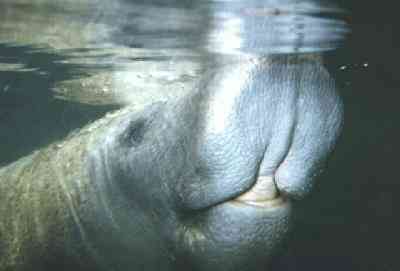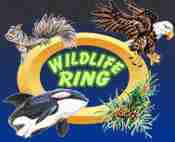General Information

General Features:
The West Indian Manatee is a large, gray-brown, aquatic mammal. In Puerto Rico they are more abundant along the southern coast and in some river mouths. They are commonly known as sea cows and their scientific name is Trichechus manatus. The West Indian manatee is an endangered species. This means that there is only a few remaining: in Puerto Rico it is estimated that there are only between 300 and 400 manatees, We should help save this magnificent species from extinction before it is too late.
Manatees have a
seal-like body that tapers to a flat, paddle-shaped tail. Their
two small forelimbs on the upper body are shaped as flippers and
have three or four nails on each flipper. The head and face are
wrinkled and the snout has stiff whiskers. Like most aquatic
mammals, body hair is almost absent. Adults normally weigh 1,000
pounds and measure 9 feet, but they can reach thirteen feet and
weigh 3,000 pounds. At birth, manatees are approximately four
feet long and weigh between 60 and 70 pounds.
Distribution:
Manatees that are found in Puerto Rico belong to a species that also inhabits the warm waters of the Americas. There are other species in Africa, the Amazon River, and the Pacific Ocean. Manatees are more common along Puerto Rico's southern and east coasts, specially in the waters surrounding Roosevelt Roads Naval Station in Ceiba and Jobos Bay in Guayama. They are also abundant along Vieques' northwestern coast, at Guayanilla Bay, at La Parguera, at Bahia Sucia in Cabo Rojo, and at the mouth of the Guanajibo River in Mayaguez. Manatees are not common on the north coast of the island, but they are sometimes seen from La Plata River Mouth in Dorado lo Fajardo and in the Isabela-Aguadillia area.
Why Manatees Are Endangered:
Manatees are large, slow, gentle, inoffensive animals. They spend most of their time feeding along the coast or resting on the water surface. These habits make them susceptible to boat collisions, which is the major cause of human-related manatee deaths. Small boats with outboards engines often cause wounds, scarring, and even deaths. Large power vessels and barges moving through shallow water can also run over manatees, crushing them against the bottom. Sometimes an increase in boating activities in areas preferred by manatees can scare them to sub-optimal habitats affecting their survival.
Fishing nets are another cause of death. Sometimes manatees get tangled on fishing nets and drown. Debris such as discarded fishing lines and hooks, plastics, and other objects disposed in the ocean and rivers can create serious problems to manatees and other marine animals. Other causes of human related mortality among manatees are pollution, harassment, and vandalism.
Manatees are endangered because every year more manatees die that those that are born. Their natural reproductive capacity is low. Humans have fostered conditions that threaten their survival.
Laws that protect manatees:
Manatees are protected by laws created by the governments of Puerto Rico and the United States. In Puerto Rico they are: "Ley de Pesca" or Law #83 (1943), "Ley de Vida Silvestre del Estado Libre Asociado de Puerto Rico" (1976), and the "Reglamento para Regir el Manejo de las Especies Vulnerables y en Peligro de Extinction en el Estado Libre Asociado de Puerto Rico" (1985). The United States laws are: Marine Mammal Protection Act, (1972), and the Endangered Species Act (1973). Violators can be sentenced to up to one year in prison and/or be fined up to $20,000 for a criminal offense under some of these laws.
Information:
Manatees are totally inoffensive animals. They feed mostly on sea grasses that are common on shallow, calm, coastal waters. Their preferred sea grass is Thalassia, Since they need air for breathing, manatees are usually found on the water surface. They have been known to hold their breath for as long as 20 minutes, but they usually surface to breath every four minutes or less. When diving, they close their nasal apertures that are located above their mouth.
Manatees have small eyes that are covered by a protective membrane. Sight appears to be poor. They have small openings behind their eyes and seem to hear very well in the water. They can communicate by sound specially when playing, during breeding or when they are scared. Communication is more common between a mother and her young.
Manatees have a low reproductive capacity. They usually bear one calf although twins have also been recorded. Intervals between births range from three to five years. The gestation period is approximately thirteen months, one of the longest among animals. Mothers nurse their young for a long period and a calf may remain dependent for up lo two years. Manatees do not become sexually mature until five to nine years of age, They live long fives, a manatee in captivity has lived over 41 years.
What you can do to save the Manatee:
Manatees are disappearing from the coasts of Puerto Rico principally due to human activities. We can change this trend by taking action to prevent their extinction.
- If you boat, and see a manatee, slow your speed to a minimum. Operate boats at low speeds where manatees are known to be abundant.
- If you dive, remember that manatees are often shy of humans. Be careful not to frighten them. Photography is fine, but SCUBA gear may frighten them away. Snorkeling may increase your chances of getting closer.
- If you fish, do not discard monofilament lines and hooks to the ocean- Manatees can get hurt or die by eating lines tangled in sea grasses that they eat.
- If you have friends that practice aquatic sports, talk to them about this inoffensive creature. Manatees are tame animals and will never attack humans.
- If you are a fisherman, and a manatee gets tangled in your net, release him as soon as possible, if not the tide will drown him. There is no reason to be afraid of manatees, they will not attack you.
- If you are an educator, take time to explain to your students about this magnificent species, their problems, and how to protect them from extinction.
- If you find an
injured or dead manatee, please contact the Caribbean Stranding
Network at: 899-2048 or (800) 462-8124 or 782-8686 unit 124-3565
or contact your local office of the Department of Natural
Resources.


Homosassa Springs Wildlife Park
The Call of the Siren!
  This Wildlife Ring site is
owned by This Wildlife Ring site is
owned by Deborah Fleming. Want to join the Wildlife Ring? |
|---|
| [Skip Prev] [Prev] [Next] [Skip Next] [Random] [Next 5] [List Sites] |